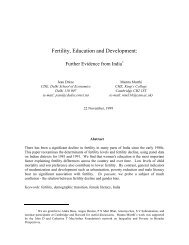Create successful ePaper yourself
Turn your PDF publications into a flip-book with our unique Google optimized e-Paper software.
and tigers. Massive double doors, twelve-paneled, with heavy iron studs, open<br />
tantalisingly on to huge inner courtyards.<br />
A blood-drenched history and complicated mythology are attached to the landmarks<br />
and constructions of Kathiawar. On the coast to its west, at Dwarka, is the place<br />
where Lord Krishna died. To the south, the temple of the moon at Somnath is a<br />
centre for Hindu pilgrims from all over India. In the steep Girnar hills above the city<br />
of Junagadh, long staircases take pilgrims to Jain temples dating back to the 3rd<br />
century BC.<br />
Looming over Junagadh city, the fortified rock-citadel of Uparkot has inscriptions and<br />
cave-sculptures from the time of the 3rd century BC ruler Ashoka. <strong>The</strong> city was an<br />
important centre for Hindu rulers of Gujarat in the first millennium. <strong>The</strong>n, starting<br />
with the Afghan warlord Mahmud of Ghazni, who invaded in 1024 AD and pillaged<br />
Somnath, Junagadh suffered four centuries of sackings. Mughal rule gave it some<br />
stability with Muslim rulers controlling its largely Hindu population. Both its rulers<br />
and its people were passive onlookers in the contest for India’s trade among the<br />
English, Dutch and Portuguese, whose galleons fought vicious battles off the Gujarat<br />
coast. A five-metre long cannon broods over the town from the ramparts, a relic of<br />
an unsuccessful attack on the Portuguese trading post at Diu, on the coast southeast<br />
of Junagadh, by the feet of Sultan Sulaiman the Magnificent of Turkey in the 15th<br />
century.<br />
At night, seen from the coastline at the south of Junagadh, processions of navigation<br />
lights travel left and right along the horizon. <strong>The</strong> seaborne traffic between the west<br />
coast of India and the Arabian ports goes on as it has for millennia, ever more<br />
intense.<br />
Gujarat was the trading hub of ancient India, where Indian cottons and silks were<br />
traded to Arabs and later the first English East India Company in return for silver,<br />
gold, incense and coffee from the Red Sea port of Mecca. Up until the early 15th<br />
century, Chinese junks had also come to western India. Later India and India-based<br />
European traders became the trade intermediaries between the Arab and Chinese<br />
spheres. <strong>The</strong> Gujaratis were prominent in this pre-colonial Indian Ocean trading<br />
network, with the wealth of India in its cloths, indigo, opium and spices merchandise.<br />
<strong>The</strong> small ports of Kathiawar took part in this trade. Diu handled much of Gujarat’s<br />
trade with Aden in the west and Malacca in the cast. Gold, silver, quicksilver,<br />
vermilion, copper and woollen cloth would be exchanged for Indian gold and silver<br />
embroideries and brocades and for cotton muslins of a fineness expressed by trade<br />
terms such as abrawan (running water), baft hava (woven air) or shabnam (evening<br />
dew).<br />
Later of course the East India Company grabbed its monopolies in opium, tea, indigo<br />
and spices in a three-way trade equation between China, India and Europe, topped<br />
up later by the British Empire with gold bullion from Britain’s new colonies in South<br />
Africa and Australia at the southern corners of the Indian Ocean. Indian<br />
entrepreneurs-in Calcutta the Marwari traders and moneylenders originally from<br />
Rajasthan, in Bombay the Parsis (Zoroastrians originally from Persia)-began moving<br />
into large-scale industrial production late in the 19th century.<br />
Smaller traders also took advantage of Pax Britannica by taking steamer passages to<br />
all corners of the Indian Ocean and Southeast Asia-no passports were needed-and<br />
opening small stores and service stations. Most were from Gujarat; a large




